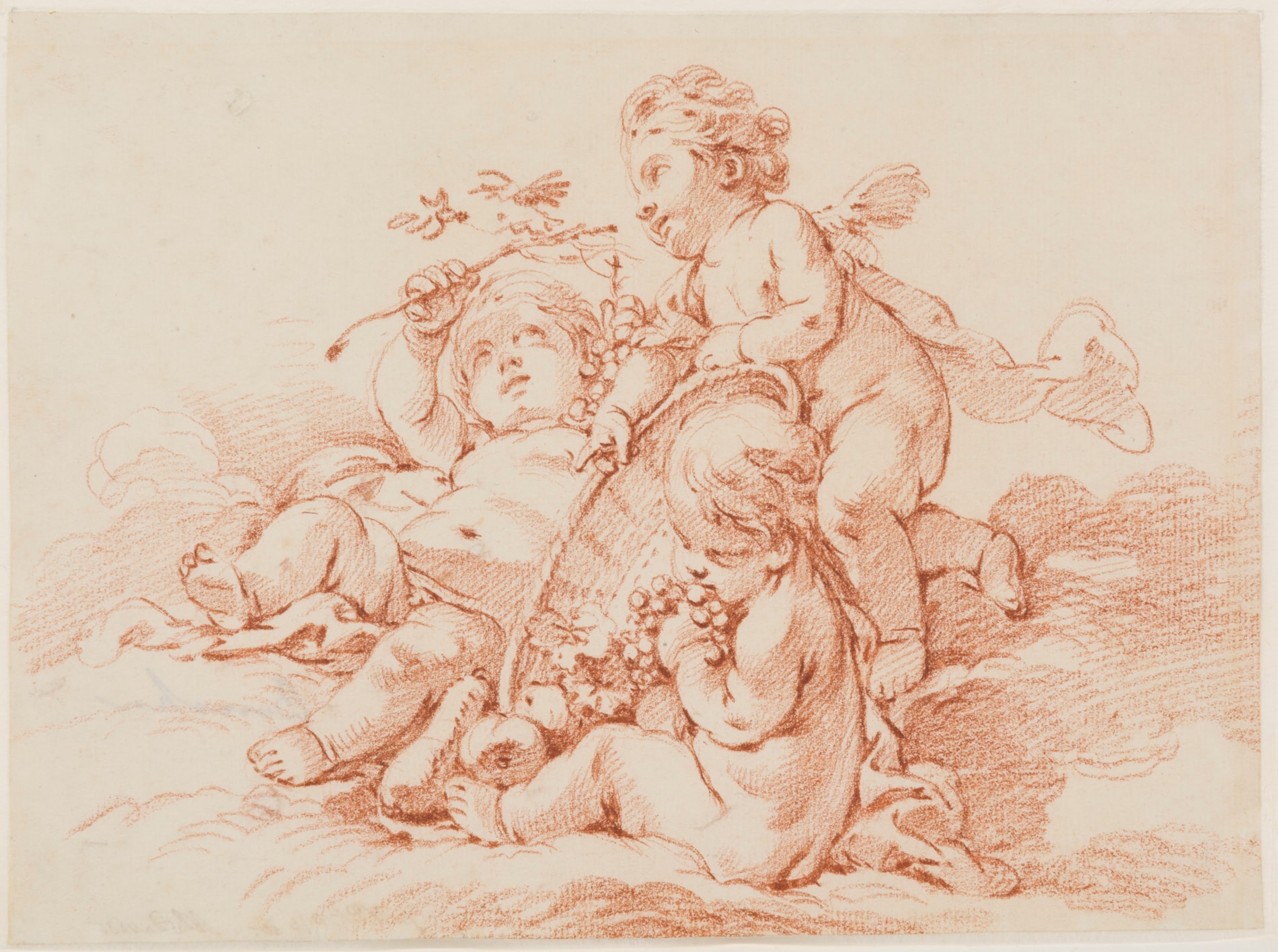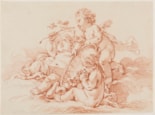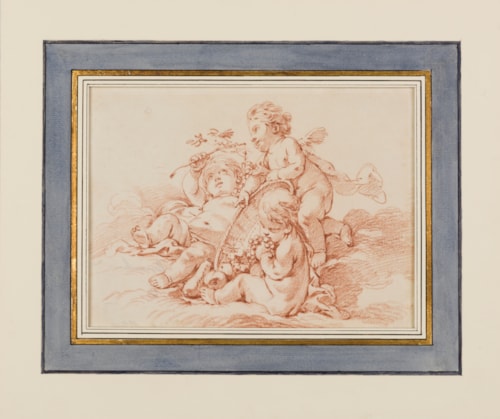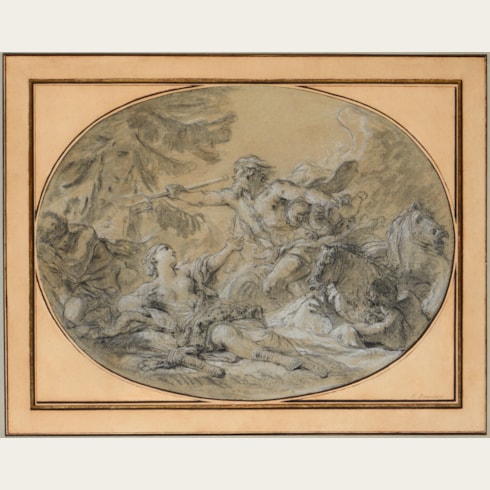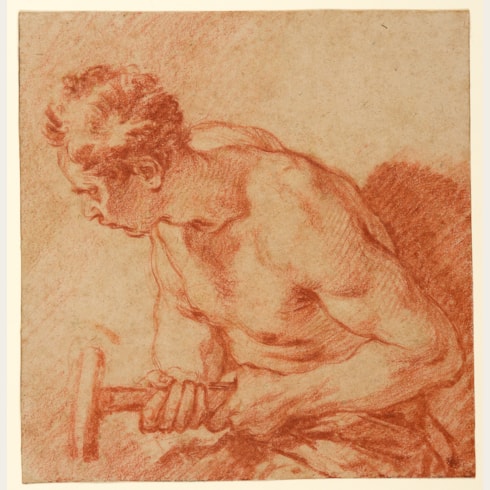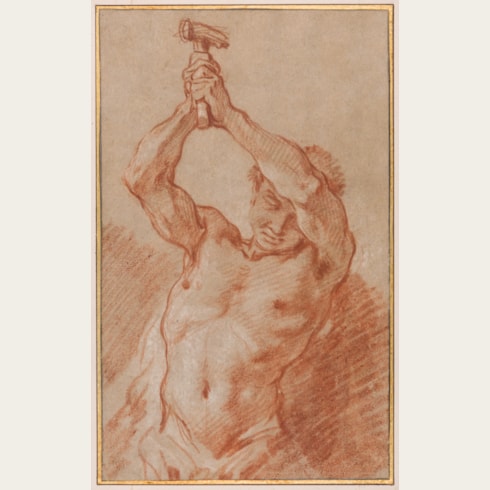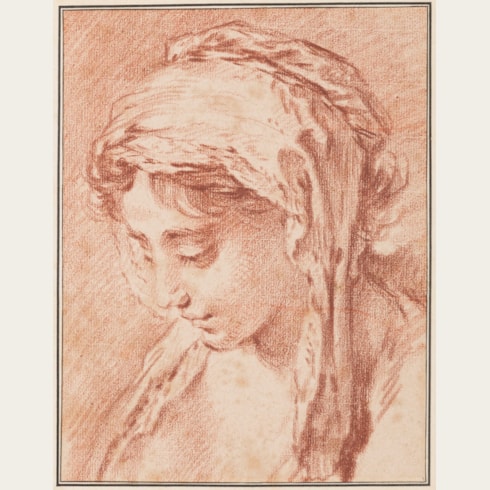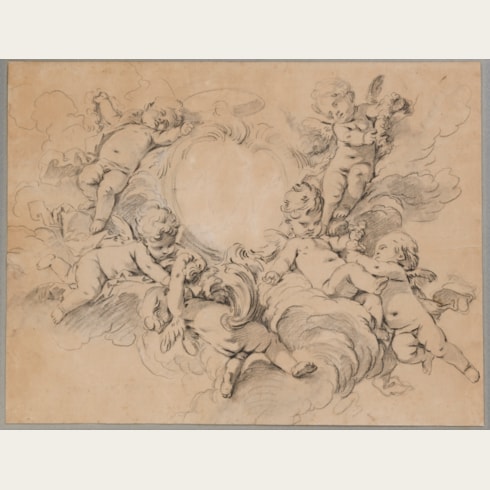François BOUCHER
(Paris 1703 - Paris 1770)
Autumn: Three Putti with a Basket of Grapes
Inscribed Boucher in pencil on the verso.
Further inscribed for W.P.A 31/3 50. M Dund(?) 35 on the verso.
174 x 234 mm. (6 7/8 x 9 1/4 in.)
This charming red chalk drawing is Boucher’s preparatory study for Autumn, one of a series of etchings of the Four Seasons by Louis Félix de La Rue, all after drawings by Boucher, that were published by Gabriel Huquier, the leading print publisher, engraver and collector in Paris for much of the 18th century. Datable to after 1745, the four etchings are among a series of various prints of putti after designs by Boucher, issued by Huquier in the form of cahiers, or sets. The preparatory drawings by Boucher for these prints, including the present sheet, all belonged to Huquier and were sold at auction following his death in 1772.
The present sheet appears to be the only extant preparatory drawing for the Four Seasons. A stylistically comparable red chalk drawing of Two Putti with Doves by Boucher was formerly in the collection of Max Loeb in Paris, while a counterproof of the Loeb drawing appears on the verso of a similar drawing of Two Putti in the Musée d’Art et d’Histoire in Geneva. Also similar is a drawing of Three Putti with Trophies, Palm Fronds and a Laurel Garland in a private collection in Brussels. The seated putto in the foreground of the present drawing is repeated in reverse (and thus likely based on the related etching of Autumn) in an overdoor painting of An Allegory of Autumn by Boucher and his workshop, signed and dated 1753, formerly in the Edmond de Rothschild collection in Geneva and today in the Metropolitan Museum of Art in New York.
Margaret Morgan Grasselli has noted that ‘No other eighteenth-century artist…depicted children so frequently and to such varying effect: to parody adult activities; to allegorize the seasons, the time of day, the four elements, and the arts; to enliven, observe, attend, and comment on mythological or historical events; or simply to show them being children.’
Appointed a professor at the Académie Royale in 1735, Boucher painted numerous easel pictures – pastoral landscapes, religious and mythological subjects, genre scenes, chinoiseries and portraits – for private clients in France, Sweden, Denmark, Germany and Poland, while also producing several tapestry cartoons for the Beauvais and Gobelins manufactories, where he succeeded Jean-Baptiste Oudry as inspecteur des ouvrages in 1755. He designed stage sets and costumes for the Opéra and the Opéra-Comique in the 1740s and created designs for Vincennes and later Sèvres porcelain throughout the 1750s and early 1760s. In 1765 Boucher was named premier peintre du roi, or First Painter to the King, and also appointed director of the Académie Royale. In 1770 he died at his lodgings in the Louvre and was buried in the church of Saint-Germain l’Auxerrois. Among his pupils were Jean-Baptiste Deshays and Pierre-Antoine Baudouin, both of whom became his sons-in-law and predeceased him, as well as Jean-Honoré Fragonard, Jean-Baptiste Le Prince and Gabriel-Jacques de Saint-Aubin.
A gifted draughtsman, François Boucher was as prolific as he was talented, and claimed to have produced ten thousand drawings over a career that lasted some fifty years. He was, in fact, perhaps the most prolific French draughtsman of the eighteenth century, and his drawn oeuvre includes pastoral scenes, nudes, religious, historical and mythological subjects, book illustrations, chinoiseries, landscapes, genre scenes, studies of children and heads, as well as designs for tapestries, porcelain and fountains. Although most of his drawings were preparatory studies for his paintings, Boucher also produced finished drawings as independent works, often adapting and elaborating a head or figure from one of his paintings. While his preference was for black, red, and (particularly in his later years) a dark brown chalk, he also made highly finished drawings in pastel and, at times, drew on coloured paper. As Pierre Rosenberg has succinctly noted, ‘Boucher’s love of drawing never waned with time and success. Admittedly, drawing was kept in its proper place, as a vital link between the conception or the idea of a work or composition, and its realization, its metamorphosis into a painting…To quote Mariette, Boucher “was a born painter”, but he placed great emphasis on drawing throughout his entire career.’ Boucher’s drawings were avidly collected in his lifetime by such connoisseurs as Barthelémy-Augustin Blondel d’Azaincourt, Paul Randon de Boisset, Pierre-Jacques-Onésyme Bergeret de Grancourt, Gilbert Paignon-Dijonval, Jean-Claude Gaspard de Sireuil, Count Carl Gustaf Tessin, and many others.
Boucher's drawn oeuvre includes all manner of subjects, including pastoral scenes, nudes, religious, historical and mythological subjects, book illustrations, chinoiseries, landscapes, nudes, genre scenes, studies of children and heads, as well as designs for tapestries, porcelain and fountains. He produced many finished drawings as independent works, often adapting and elaborating a head or figure from one of his paintings. While his preference was for black, red, and (particularly in his later years) brown chalk, Boucher also made highly finished drawings in pastel and, at times, drew on coloured paper. A large number of his drawings were finished works for collectors and the art market, and many were engraved and reproduced in considerable numbers – often making use of new printmaking techniques that allowed chalk drawings to be reproduced with a high degree of verisimilitude - by such printmakers as Louis-Marin Bonnet, Gilles Demarteau or Gabriel Huquier. His drawings were greatly admired, and while many were preparatory studies for his paintings, others were produced as finished works of art, to be sold to collectors or reproduced by engravers. Indeed, Boucher’s popularity as a draughtsman owes much to the fact that many of his drawings were reproduced and widely distributed as engravings.
Provenance
His sale, Paris, rue des Mathurins [Joullain], 9 November – 4 December 1772, part of lot 374 (‘Les quatres Saisons, idem; elles ont aussi été gravées par la Ruë& portent 6 pouc. 10 lig. de haut sur 9 pouc. 3 lig. de large.’, bt. Chariot for 94 livres, 1 sou)
Madame R. Blay
Her sale (‘Collection de Mme R. Blay’), Paris, Hôtel Drouot [Lair Dubreuil], 4 July 1929, lot 14 (as School of Boucher)
Private collection.
Literature

